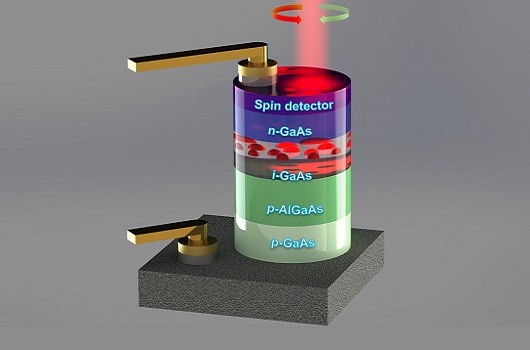A new step forward for spin photodiode physics and technology

A spin photodiode detects circularly polarised light thanks to a stack of semiconductor and ferromagnetic materials.
Electronics is based on an elementary particle, the electron, and in particular on its electrical charge. More recently, another field of research has emerged, spintronics, which adds a second quantum property of the electron to electronics: its "spin", which corresponds in some way to a magnetisation. Although its applications are still less developed than those of classical electronics, spintronics is the basis of the reading heads of computer hard disks and magnetic memories (Magnetic Random Access Memory), and remains a rapidly expanding field of research.
"In this work, we combined spintronics with optics. This is spin-optoelectronics," explains Henri-Jean Drouhin, co-author of the study published in Physical Review Letters and head of the 'Physics and Chemistry of Nano-objects' group at the Irradiated Solids Laboratory (LSI*). Light particles, photons, also have a spin. This spin manifests itself in the fact that light can be right- or left-handed circularly polarised (which means that the electric field of the light winds to the right or left like a helix in the direction of propagation of the photons). When this light hits the device designed by the researchers, photons can excite electrons in the material. The spin of these electrons then adopts a preferential direction that depends on the photon spin.Knowing how to selectively extract the electrons therefore makes it possible to obtain information on the polarisation of the incident light, making these devices 'spin photodiodes', in contrast to conventional photodiodes that measure the intensity of the light.
Thanks to nanotechnology, laser sources already exist that produce circularly polarised light from the spin of electrons. With detectors that work on the opposite principle, new fields of application could be opened up. "They exist, but they are not yet effective," explains Henri-Jean Drouhin. With his colleagues from CNRS/Thalès, Institut Jean Lamour (CNRS/Univ. de Lorraine), Ioffe Institute in Saint Petersburg and Chinese Academy of Sciences, they have therefore carried out experimental and theoretical work to understand precisely the mechanisms at work in their device. The device consists of several stacked materials. A semiconductor (gallium arsenide, already widely used in electronics), where photons are converted into electrons. A ferromagnetic metal (an alloy of cobalt, iron and boron) into which the electrons penetrate more or less easily depending on the direction of their spin and which enables the useful electrical signal to be recovered. Between these two materials, a layer of insulator (magnesium oxide) regulates the passage of electrons by tunneling effect.
The researchers have succeeded in reconstructing the different mechanisms of electron creation and loss and found out how to control them with the help of electric and magnetic fields. A balance is needed between these mechanisms while maintaining competition between the different spin directions of the electrons. "If you collect all the electrons in an undifferentiated way, then you get no information," explains Henri-Jean Drouhin. "In our article, we also perfectly modelled the physical phenomena involved, and also tested that this model worked for different ranges of voltages and magnetic fields applied to the device," emphasises Slava Safarov, co-author of the study at LSI.
Although this work is still very basic, the team considers that it points the way to the future development of efficient detectors that could be used for telecommunications, information processing or medicine.
 Support l'X
Support l'X